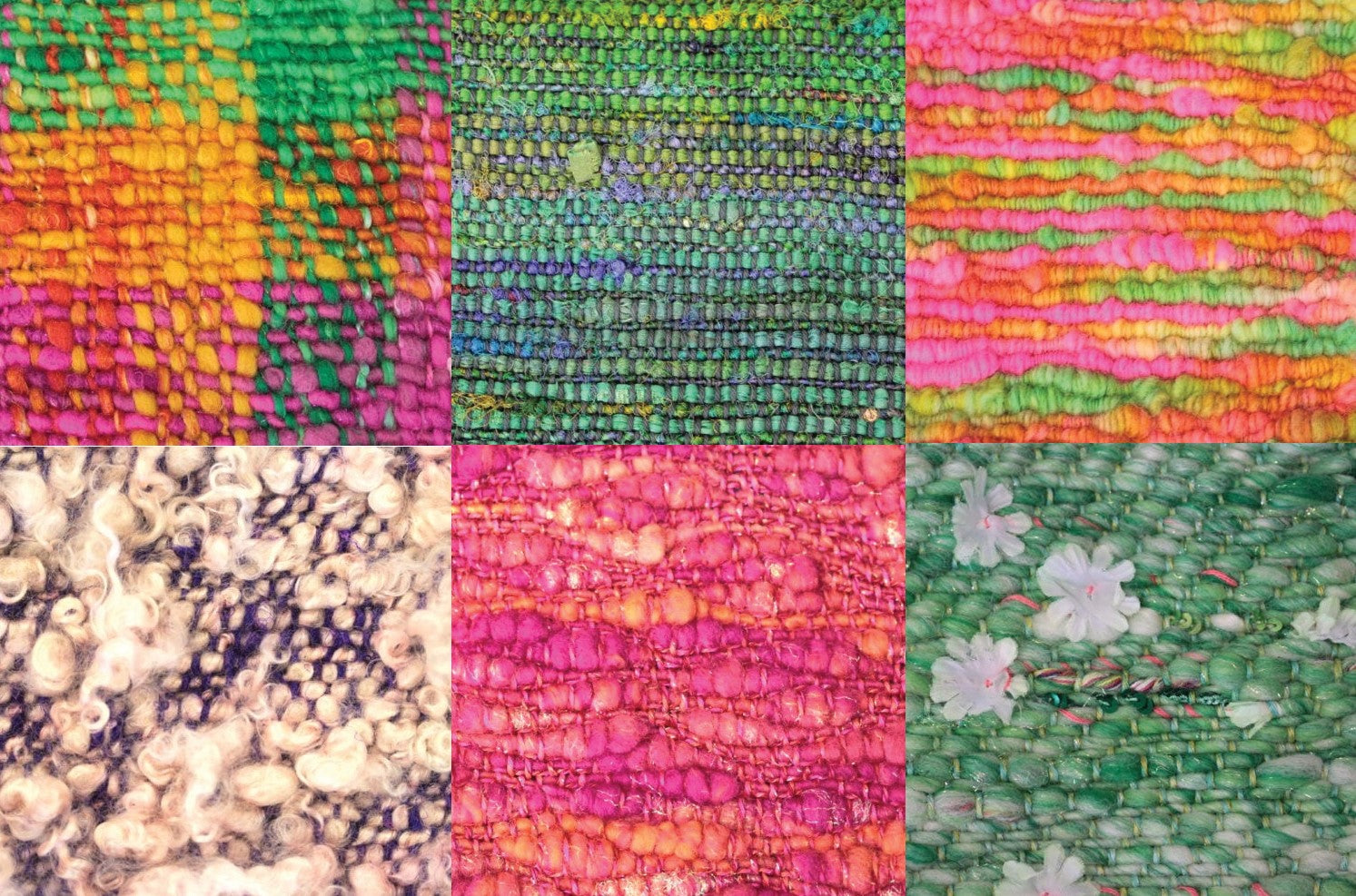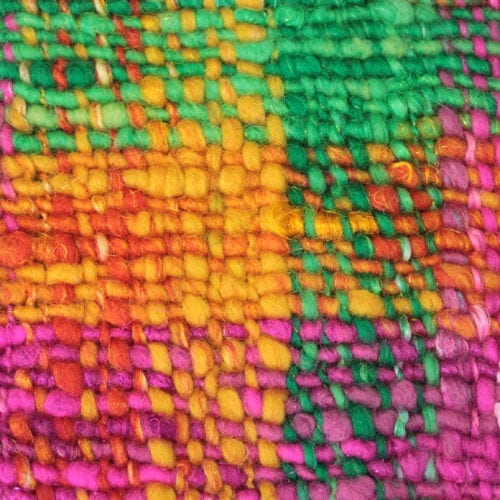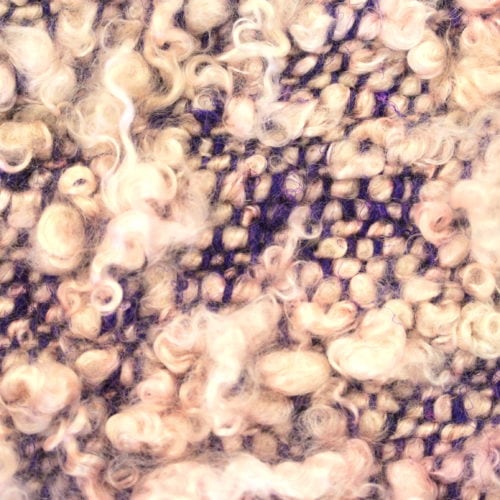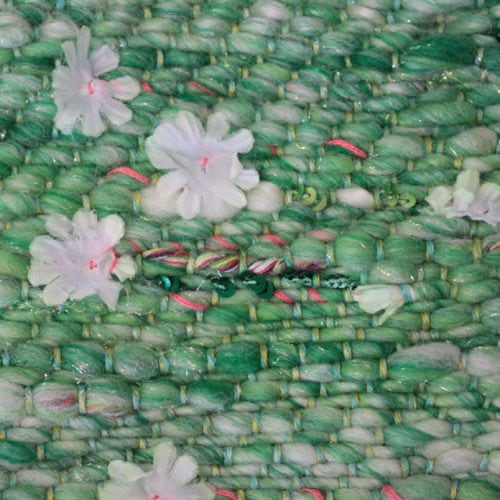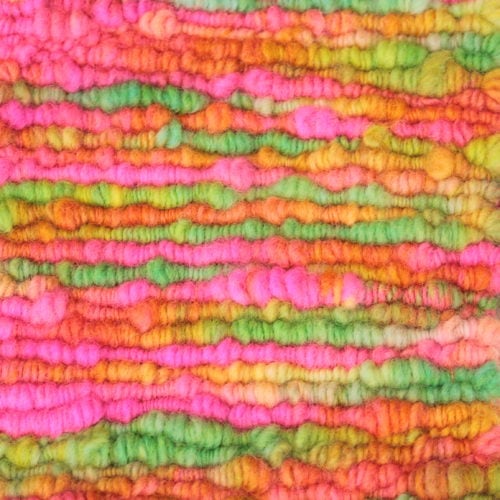By Denise Renee Grace
Art yarn, whether you spin it yourself or purchase it readymade, is a catalyst for creative woven fabrics.
Art yarn spinning techniques are so much fun to do and make such beautiful and unique yarns. What follows often, though, is the question, “what do I do with it?” Due to the stitch structure of knitting and crochet, the irregular gauge that art yarns tend to produce uneven results. Weaving, however, is the perfect technique to turn textured yarn into interesting, fun fabric. For those who don't spin, but would like to experiment with weaving textured yarn, I also experimented with some commercially-available yarn in my explorations to good effect (I’ve cited the companies below).
Using art yarn in the weft is an obvious choice because you can use just about anything in the weft, but it can also be exquisite used in the warp, as well as in both warp and weft.
I like using rigid heddle looms for my art yarn projects because there is less loom waste, as well as less abrasion than on a floor loom. You can also get away with using less warp tension on a rigid heddle loom.
I wove plain weave on my Cricket or Flip loom for all of the fabrics shown here, except for one twill weave structure, which I wove on my Wolf Pup LT. The variable dent reed is another great tool to consider when working with irregular or art yarns.
I think most of us have our go-to projects that we like to create. Mine happens to be bags. I have found that art yarn makes superb bags, but it can also be used for other items, such as pillows, scarves, vests, or even a table runner for modern centerpiece.
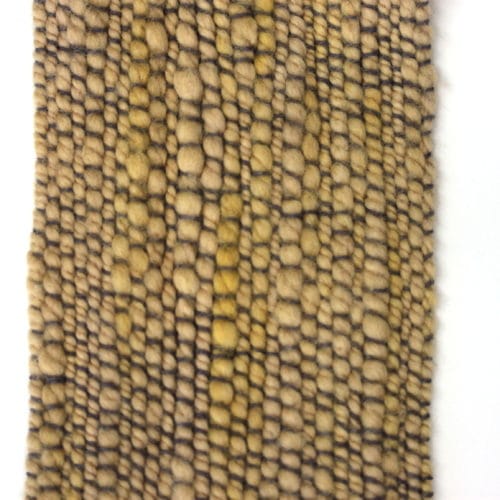 Thick-and-thin Used in Warp
Thick-and-thin Used in Warp
Thick and thin is one of my favorite spinning techniques and probably the easiest of the art yarns to spin. I love showcasing the yarn by putting it in the warp and crossing it with a thin weft. Sometimes, I even use sewing thread in the weft if the warp yarn has a lot of color movement, allowing the warp be the star of the piece. I can see this fabric used vertically for a vest or coat. To see if your yarn is suitable for warp, check that it will fit through the slots and holes in your heddle and give it a strength test. To do this, pull on a length of yarn, if it comes a part with a snapping sound, it should be strong enough. If the yarn pulls apart noiselessly, you might question its warp worthiness.
Warp: Hand spun merino top spun thick and thin in both singles, then plied for a 2-ply yarn (7 wraps per inch), dyed with eucalyptus and turmeric.
Weft: 8/2 unmercerized cotton in grey.
Weave: Plain weave, 5-dent reed with 5 picks per inch, woven into a skinny scarf.
Art Yarn in Warp and Weft (Plaid Color Effect)
Lively hand-dyed, hand-spun yarn wove up to be a beautifully bright and unconventional plaid. Using art yarn in the warp and weft, made a thick, fluffy fabric, perfect for bag making. Surprisingly, the fabric is soft enough that it could even be a cowl. The color, texture, pattern, and sparkle create movement and true joy for the eyes. For this project, I did not pull the locks of mohair out while weaving, so there are only small bubbles of it here and there. Two similar colorways and fibers, created by the same maker, give the fabric a cohesive feel.
Warp: Spinning Wheel Studio Thread, plied yarn using a large single of hand-dyed merino top, mulberry silk, sari silk thread, mohair locks, and firestar plied with a thin metallic thread (5 wraps per inch).
Weft: Spinning Wheel Studio corespun single hand-dyed merino top, mohair locks, firestar, angelina, mulberry silk, and sari thread (7 wraps per inch).
Weave: Plain weave, 5-dent reed with 5 picks per inch, fabric to be used for an envelope satchel or cowl.
Locks and Sari Silk for a Textured Surface
Tail spun yarn makes for a pleasingly tactile yarn. I pulled the locks out while I wove so they would float on the surface of the fabric. This would make such a fun little clutch purse.
Warp: Frabjous Fibers Recycled Silk Yarn-handspun by women's cooperatives from silk weaving mill waste (8 wraps per inch).
Weft: Fancy Fibers tail spun locks.
Weave: Plain weave, 5-dent reed with 3 picks per inch, could be made into a purse or an accent pillow.
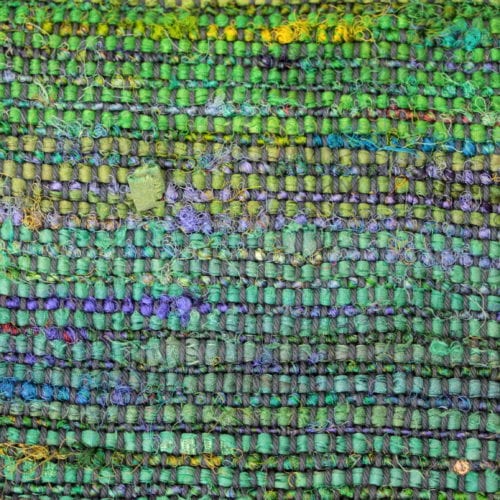
Silk Extravaganza: Art Yarn in the Weft
Continuing with more silk, I felt I could enhance the texture of silk further by alternating recycled silk yarn with sari ribbon, alternating every other one in the weft with a cotton warp. This fabric has an amazing hand without compromising any structural integrity.
Warp: cotton carpet warp in navy.
Weft: Frabjous Fibers Recycled Silk Yarn in "sea," Frabjous Fibers Sari Ribbon in "teal" and "emerald." These colors are hand-picked from silk weaving-mill waste and the silk fibers of similar color are spun together into one yarn, while the ribbon is sewn into yarn.
Weave: Plain weave, 10-dent reed with about 6 picks per inch. Since the fabric is so pliable and durable, it could be used for many things.
Maximum Weft Texture
This is probably one of my favorite fabric results of my art yarn explorations. It really shows off the yarn with maximum texture. The color, texture, and a hint of sparkle make this bag fabric irresistible.
Warp: Knit Collage Maharani Silk in "firework."
Weft: Knit Collage Pixie Dust in "azalea bloom." Knit Collage yarn is hand spun by women in India.
Weave: Plain weave, 8-dent reed with varying picks per inch (due to thick and thin nature of the yarn).
Manipulating a Commercial Yarn
Although I love plain weave, mostly because I am truly interested in color and texture, I wanted to try at least one twill sample. Yarn with inserted objects works well with twill due to its longer weft floats. I manipulated the flowers as I wove by lifting them up to the surface of the fabric. I beat this fairly firmly because I wanted it to be a rather large tote bag, which required a rather stiff and sturdy fabric.
Warp: Knit Collage Maharani Silk in "key lime pie."
Weft: Knit Collage Gypsy Garden in "emerald forest."
Weave: 4-shaft point twill, 8-dent reed with about 6 picks per inch.
Weft Emphasis Fabric
One of the most impressive samples that came from this study was the use of my handspun coil-spun yarn. This, more than most art yarns, would be difficult to crochet or knit, but it wove up like a dream. Using a 20/2 cotton in the warp, it disappeared and all that was left were the scrumptious coils.
Warp: 20/2 mercerized cotton in a bright orange color.
Weft: Spinning Wheel Studio Hand-dyed Falkland Wool Top super coiled.
Weave: Plain weave, 10-dent reed with about 5 picks per inch. This will become a lovely spindle bag.
Through this exercise, I (re)learned that it is important to try new things, to have fun and play with yarns on the fringe. I would advise starting with art yarn in the weft and using smaller, smooth yarns in the warp. There are no hard and fast rules about sett when it comes to art yarn, so intuition and bravery are key to adventures with textured yarns. I hope that this has inspired you to try out your own art yarn in weaving, as well as to try some of those novelties that you love but don’t know how to use.

